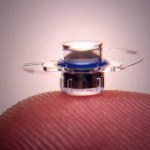Vision
There is this commercial that has been coming on lately showing some people reading the Kindle at the beach. Why is this a selling point? It has to do with the way the Kindle works compared to something like the iPad. I would take a picture, but I have neither of these devices. Instead, I will make a diagram.
Maybe you can't tell from my diagram, but I am using the black rays to represent light reflected from the Kindle and red rays to represent light produced from the iPad. And that is the key. The Kindle does not have a light source, it is very similar to a piece of paper. The iPad…
My grandmother suffered in her old age from macular degeneration, a common age-related eye disease that causes the center of your visual field (the macula) to gradually fritz out. As it affected her more and more, the font size in her emails ballooned to cartoonish sizes. She began walking with a cane, and needed a fancy electronic doo-dad to tell her when her cup of tea was full. By the end of her life, she was totally blind.
Watching my grandmother wink out from the world of seeing was tragic; the knowledge of macular degeneration's heredity terrifying. Relatives of those who have…
Over at Tor.com, Kate has a Lord of the Rings re-read post about the Battle of the Pelennor Fields, which includes a shout-out to me that I missed because I was driving to NYC:
Ãomer is "scarely a mile" away when the standard unfurls and is clearly seen to bear the White Tree, Seven Stars, and a high crown. If I were at home, I could ask the resident scientist to tell me how big these elements would need to be to be visible at a mile, but I'm finishing this post on the train down to New York City (vacation! Woo! I'm going to try and write the next post while I'm there, too, so as to make up…
I'm sure by now you've heard about inattentional blindness, as I've posted about it a million times since this blog began. It's an amazing effect! It shows us that we really aren't as aware of the world as we think we are. If you haven't heard about it by now I encourage you to go right here to try out a demo on yourself! Inattentional blindness isn't the only time this happens though, there are a number of cognitive illusions that make you realize you're a lot stupider than you thought you were.
There's a brand new book out today by the semi-discoverers of inattentional blindness (well…
This year I was asked to participate in the Illusion of the year contest and it was a blast! There were a bunch of great illusions and I had no idea who was going to win it until the votes were counted. There's even some great video of me acting in one of the presentations. Anyway here's a video of one of the contestants using me - can you guess who I am?
Keep reading for a video of the 1st place winner and links for the 2nd and 3rd place winners!
Here's the first place illusion:
And 2nd Place and 3rd Place. Both totally worth watching on neuralcorrelates.org.
The monkey business illusion.
Did it work on you?
This video is great especially since most people studying psychology have seen the original gorilla video. This even worked on a group of the most important vision scientists in the world at a recent Vision Sciences Society annual meeting.
Also, check out the invisiblegorilla.com for more videos and posts by Dan Simons!
tags: Optical Illusion: Impossible Motion, optical illusion, Koukichi Sugihara, Best Visual Illusion of the Year Contest 2010, vision, brain, streaming video
In this video, wooden balls roll up the slopes just as if they are pulled by a magnet. The behavior of the balls seems impossible, because it is against gravity. The video is not a computer graphic, but a real scene.
What is actually happening is that the orientations of the slopes are perceived oppositely, and hence the descending motion is misinterpreted as ascending motion. This illusion is remarkable in that it is generated by a…
Today for Monday Pets, we're going to go old school and talk about vision.
Vision is arguably our most (intentionally) utilized sensory system, so its pretty important to figure out how it works. And it's what David Hubel and Torsten Wiesel set out to investigate starting in the late 1950s. Ultimately, their work would get them a Nobel Prize in Physiology or Medicine, in 1981.
Basically, they took a bunch of cats, anesthetized them, and showed them patterns of light on a screen. Meanwhile, some microelectrodes were placed in various precisely determined spots in the cat's visual cortex, and…
And it could, if done right. Even those of us who read really fast max out at around 600 words per minute. This is a result of what is known as saccadic eye movement. When we read, only a very small part of the retina, known as the fovea, is used, so as we read a line of text (and it doesn't matter if you're reading left to right, right to left, or top to bottom), your eye makes small jerks, saccades, to read the new text (if you have a video camera handy, record yourself reading this post. Nekkid. Your eyes will jerk several times per line).
The problem I have with Kindle (and other…
Click to enlarge images
ARTISTS employ a number of different techniques to represent implied motion in two-dimensional works. One of these, commonly used in posters, comics and animation, is the affine shear effect, whereby a moving object is depicted as leaning into the direction of movement. Cartoonists also use action lines to depict movement and speed, with straight lines conveying fast movements and wavy lines conveying slower ones. Motion can also be conveyed by superimposing several images showing the successive positions of a movement, or by a blurred image showing the different…
Not Exactly Pocket Science is a set of shorter write-ups on new stories with links to more detailed takes by the world's best journalists and bloggers. It is meant to complement the usual fare of detailed pieces that are typical for this blog.
Cold-proof tongue allows early chameleon to catch early insect
Chameleons are some of the most versatile of lizards. They live in baking deserts and freezing mountaintops and part of their success hinges on a weapon that works just as well in the warmth as in the cold - its tongue. Relying on stored elastic power for its ballistic strike, the…
Here is a picture of something you have seen before.
These are two pictures of the same location in my house. The one on the left is taken when the Sun was up outside and the other one when it was dark outside. For both pictures, I had the same lights turned on inside. So, why does it do this? Why can you see stuff outside when it is bright outside, but you don't see a reflection of the stuff outside? Why when it is dark outside, does the opposite happen? You know what I am going to do next, right? Diagram. Here is a diagram for when it is dark outside.
The person can see the blue…
WE tend to assume that we see our surroundings as they really are, and that our perception of reality is accurate. In fact, what we perceive is merely a neural representation of the world, the brain's best guess of its environment, based on a very limited amount of available information. This is perhaps best demonstrated by visual illusions, in which there is a mismatch between our perception of the stimulus and objective reality.
Even when looking at everyday objects, our perceptions can be deceiving. According to the New Look approach, first propounded in the 1940s by the influential…
A novel temporal illusion, in which the cause of an event is perceived to occur after the event itself, provides some insight into the brain mechanisms underlying conscious perception. The illusion, described in the journal Current Biology by a team of researchers from France, suggests that the unconscious representation of a visual object is processed for around one tenth of a second before it enters conscious awareness.
Chien-Te Wu and his colleagues at the Brain and Cognition Research Centre in Toulouse used a visual phenomenon called motion-induced blindness, in which a constantly…
VISION is now well known to modulate the senses of touch and pain. Various studies have shown that looking at oneself being touched can enhance tactile acuity, so that one can discriminate between two pinpoints which would otherwise feel like a single sensation. And last year, researchers from the University of Oxford showed that using binoculars to make a limb look larger or smaller than it actually is can respectively enhance and diminish painful sensations.
These phenomena occur because the brain fuses stimuli from different sensory systems to generate a coherent experience of bodily…
I've seen a lot of illusions... but this one is really f'n cool:
CHOP CUP from :weareom: on Vimeo.
-via neatorama-
So how does Superman do it! He can see through buildings and clothing (he checks out Lois Lane's underwear in Superman 1 - more on this later). Many have attempted to answer this question of the ages yet few have explored this in as much depth as J.B. Pittenger who published a study in the journal Perception back in the stone ages (1983) entitled "On the plausibility of superman's x-ray vision"
But first, before we get into the meat of the paper, lets see what others around the InterWebs have said about Superman's amazing seeing through underwear powers.
In Correcting Misconceptions…
THE retina has an inverted structure which seems ill-suited to its function: the rod and cone cells, which are sensitive to light, and which convert light energy into electrical impulses, point backwards and are located at the back of the retina, so that light entering the eye has to pass through several layers of irregularly organized cells before it reaches them. The retina also contains nerve fibres which are positioned perpendicular to the path of light entering the eye, and many of the structures in the upper cell layers have a diameter similar to that of the wavelength of visible light…


